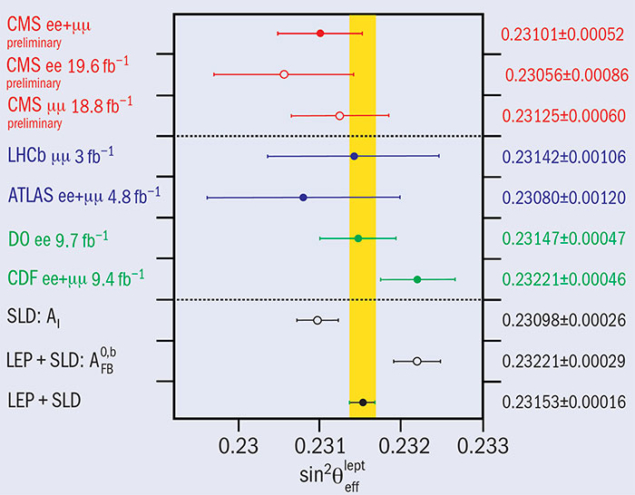
In addition to the direct production of new particles in high-energy collisions, evidence for new physics beyond the Standard Model (SM) could arise through precision measurements. Two particularly important parameters in this regard are the mass of the W boson, Mw, and the electroweak mixing angle, sin2θW. The CMS collaboration has recently reported a precise measurement of the effective electroweak mixing angle based on Drell–Yan production of leptons.

The electroweak mixing angle is a key parameter defining how the SM unifies the electromagnetic and weak forces, and at first order it is related to the W and Z bosons masses by the simple expression: sin2θW = 1 − M2w / M2Z. An uncertainty in sin2θW of ±0.0005 is equivalent to an indirect measurement of Mw to a precision of 25 MeV, which corresponds to the precision of the direct measurements at hadron colliders.
The most precise measurements of sin2θW were performed at the LEP and SLD electron–positron collider at CERN and SLAC. While the uncertainties are small (0.00026 and 0.00029), the central values differ by more than three standard deviations, motivating further precise measurements. CMS aims to measure sin2θW with a precision matching LEP and SLD based on the forward–backward asymmetry of lepton pairs with an invariant mass near MZ. The asymmetry of the production of a negative lepton with respect to the direction of the quark is small in this region, as a result of the axial-vector Z boson self-interference, and is sensitive to the effective mixing angle, sin2θlepteff. In contrast, the asymmetry at higher and lower mass is much larger, originating from the interference of the weak and electromagnetic interactions, and this asymmetry is not sensitive to sin2θlepteff. The leptons are produced via quark–antiquark annihilation in the LHC’s proton–proton collisions, and limited knowledge about the quark and antiquark parton distribution functions (PDFs) lead to systematic uncertainties that currently dominate the measurement uncertainty.
Using a novel technique with lepton pairs at high and low invariant mass to reduce the PDF uncertainties, CMS has analysed the full electron and muon data samples recorded at an energy of 8 TeV and finds that the effective mixing angle, 0.23101±0.00052, is consistent with the SM prediction 0.23152±00005. With analysis of the 13 TeV LHC data, we can expect that the uncertainties will be significantly smaller and test the electroweak sector further.







